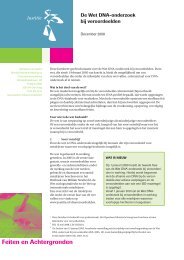INTERPOL HANDBOOK ON DNA DATA EXCHANGE AND PRACTICE
INTERPOL HANDBOOK ON DNA DATA EXCHANGE AND PRACTICE
INTERPOL HANDBOOK ON DNA DATA EXCHANGE AND PRACTICE
You also want an ePaper? Increase the reach of your titles
YUMPU automatically turns print PDFs into web optimized ePapers that Google loves.
to ensure the best possible results should also be included. All of this training should beprovided alongside the principles that <strong>DNA</strong> is not the only type of evidence that maybe available at a scene, and the most important priority is the responsibility to preservelife. This type of training would help enforce essential guidelines to ensure that as muchevidence was obtained from a scene as possible, in the best possible condition.•crime scene investigatorsThe activity within the crime scene should be controlled by a suitably trained CrimeScene Manager and his team. Training for crime scene examiners can be obtained innumerous ways, one possibility being to attend a course given by some universityinstitutes offering courses in Forensic Science, or similar, which have a focus on crimescene evidence collection. Another option is to attend a course specifically organizedfor police officers wishing to specialize in crime scene investigation. The most commonmethod of educating police personnel in this field will be through police-organizedtraining courses that focus on all aspects of evidence collection. It should be assumedthat all actions conducted will be subject to scrutiny in court, for example the collectionand preparation of samples possibly containing <strong>DNA</strong> evidence, so they should becollected by appropriately trained individuals wherever possible. All procedures shouldbe fully documented and available to all police and other forensic personnel who havelegitimate business at scenes of crime. There are international standard formats fordocumenting these procedures under the ISO Guidelines, and while it is not essentialto use them, they serve as a ready and uniform platform for this purpose and arerecommended as a good starting point.The crime scene <strong>DNA</strong> sample collection procedures established within a country/jurisdiction must ideally be identical to, or at the very least be compatible with thedocumented procedures within the forensic laboratory, and vice-versa. This will ensurethat as far as humanly possible, the training of the crime scene personnel matches thatof the laboratory staff who will analyse the <strong>DNA</strong> sample.Quality at the scene of crime is very important and there are many guidelines forquality controls. However, ideally, the guidelines set by the ISO would be the mostpreferable option to allow the same standard to be met in all jurisdictions.In summary, we can say that the first officer arriving at the scene of crime should receivespecial training and awareness regarding <strong>DNA</strong> samples. Crime scene investigatorsshould follow more advanced training courses regarding <strong>DNA</strong> samples. Trainingprogrammes should be competency-based, with a formal assessment resulting in aformal authorization, thus allowing the individual to perform the work of which he hassuccessfully demonstrated a command.TRAINING PAGE 45







